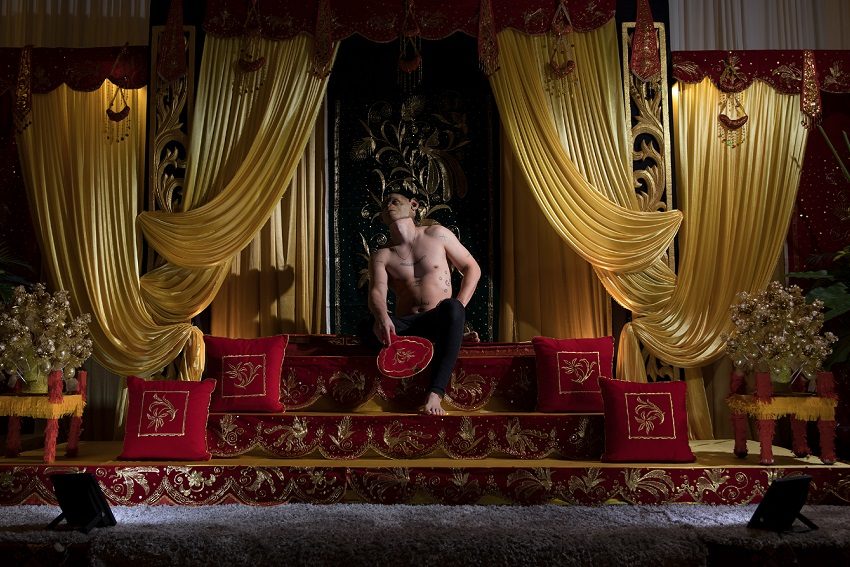ACE Open welcomes patterns of change with Waqt al-tagheer

Adelaide Festival sees ACE Open host a landmark exhibition Waqt al-tagheer: Time of Change, presented by a new Muslim Australian art entity eleven, a collective of contemporary Muslim Australian artists, curators and writers.
eleven exists as an independent creative platform from which the voices of Muslim artists can be expressed, shared and experienced with the wider Australian community. In philosophy, the collective sees contemporary art as a multi-purpose agency. It draws on Islamic art and cultural traditions to enrich individual creative journeys as well as being a means to engage with contemporary world, and within it, Australian society with its diverse challenges related to identity, religiosity, politics, gender, colour, race and class.
Consequently, in this exhibit, there are no ‘add water and mix’ Islamic art/ architecture mashups and homages but rather a lineup of distinctive, individual voices and artistic talents. And yet, despite the diversity of media and formats there is a sense of a shared aesthetic. It’s not coercive, more of an adumbration of delivery that finds expression in a mood of restraint, order and appreciation of the ritual power of form and pattern.
But one size does not fit all.
In the work of Shireen Taweel it is possible to feel hard-wired to Islamic architectural conventions with its use of pattern and the interplay of light and shadow. musallah consists of a large suspended circlet of pierced copper sheeting. Raked lighting casts shadows, highlighting the intricate, repeated patterns, readily associated with traditional pierced screens, gates and windows.

But the artist reveals that the inspiration for musallah (the term describes an open space for praying outside of a mosque) was a mosque at Broken Hill, a simple corrugated iron structure, on the site of a former ‘camel camp’ where Afghan and Indian drivers loaded and unloaded their camel teams back in the day.
The hovering characteristics of this work may be saying a great deal about the migratory nature of identity and beliefs, transposed to a new land. The certitude and open-ended beauty of the patterning suggests that the essence of what is valued most floats on into the future.
This work speaks to another, Abdullah M.I. Syed’s Aura 11, in the adjoining room. White crocheted prayer caps have been stitched together to form a half-sphere of multiple cap units, effectively an upscale version of their own selves. The symbolism, in terms of communities drawing strength and unity from individual members, is very strong.

But, in common with many works in the exhibition, this work stands on its own two feet. It is a beautiful thing. Abdul-Rahman Abdullah’s 500 Books has comparable aesthetic and physical presence, enhanced by the resemblance this work has to the monolithic structure, the Kaaba, in Mecca, which adds complexity and poetry to its meaning.
At this point it is timely to point out that not only is Time of Change a major stepping-out — a national venture — for the eleven collective but it is also ACE Open’s time to shine with the Adelaide Festival spotlights glaring and what viewers would remember as the AEAF white-cube experience translated into a cave of wonders, with works glowing against the darkness.
In such a theatrical setting, works such as Zeina Iaali’s bitter-sweet extrapolations of Arabic sweets moulds (Sweetly Moulded) that reference the “pressures women face to conform to restrictive gender roles and the ideal of perfection”, glitter like dissembling spirits; Khaled Sabsabi’s At the Speed of Light, a multiple-channel series of video panels translating the idea of ‘kashf’ (a Sufi concept dealing with knowledge of the heart rather than the intellect) offers a flickering invitation to step into a force field of pulsing light to touch base with parallel worlds of co-existence.
This subtle conversation between tradition and contemporary lived experience has a strong presence throughout the exhibition.

Photographic works exemplify the nuances of this process; Abdul Abdullah’s Journey to the West, Delegated Risk Management and Mutual Assurances, and Hoda Afshar’s Westoxicated series, introduce critical reflection or commentary, using or set within traditional tropes. Afshar, for example, turns western art idioms in the form of pop art against themselves to critique prevailing, Western representations of Islamic women. In Abdullah’s Risk Management and Assurances, the anxieties and private thoughts of individual wedding couples are wrapped in the bland stereotyping of opulent nuptial settings.
Curious would-be-viewers may wonder if this is an ‘Islamic exhibition’. From my experience, no more so than the various, diaspora-based projects of recent years. Sometimes the tug of history and originating identity is strong. At other times, such things are invisible or simply not relevant.

The co-curators of Time of Change, Nur Shkembi and Abdul-Rahman Abdullah, have no time for labels such as ‘Islamic’ or ‘Muslim’.
“Rather than defining the practice of the artist by this label, this is simply one aspect of an individual — we are multifaceted and complex creatures with long and varied familial histories — as are all people,” Shkembi says. “We connect through our creative practice and sometimes that includes connecting through various aspects of our Muslim heritage, bearing in mind that there is great diversity in this idea of being ‘Muslim’ and what that means to each individual artist within the group.”
Waqt al-tagheer: Time of change
ACE Open
Until Saturday, April 21
aceopen.art
Header image: Abdul Abdullah, Journey to the West (2017) (detail.), digital print, 75cm x 130cm. Courtesy the artist and Lisa Fehily Contemporary Art, Melbourne